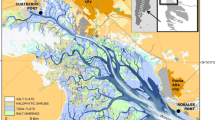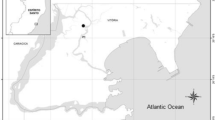Abstract
The bioaccumulation of several elements in “mouthless crabs” (Cardisoma crassum) and their concentrations in environmental samples were assessed in a mangrove forest within a natural protected area located in the middle of Puerto Vallarta, Mexico. The concentrations of Al, As, Ba, Cd, Cr, Cu, Fe, Ni, Pb, Sr, Si, V, and Zn in sediments, mangrove litterfall, and pore water and their bioaccumulations in the muscle and shell tissue of C. crassum were determined during rainy and dry seasons. Two different sampling sites were compared, selected according to the influence of the tide. The samples were analyzed by ICP-OES. In pore water, half of the elements of interest were below the limits of detection. Pb and Cd concentrations were only detected in the sedimentary phase. Al and Fe presented the highest concentrations at both sampling sites in the sediments and mangrove litterfall. There were no significant differences between sampling seasons in water samples (P > 0.05). Only Cu presented significant differences between sampling seasons in the mangrove litterfall samples and V in the sediment samples (P < 0.05). The sediment quality guidelines indicated that only Cd was above the threshold effect limit. As, Cd, Cr, Ni, and Pb remained below the limits of detection in muscle tissue and shell samples. The biota–sediment accumulation factors (BSAFs) determined for Cu and Zn were above 1.0, indicating the accumulation of these elements in the muscle tissue of C. crassum, while the BSAF values in the shell were above the threshold for Ba, Si, and Sr.


Similar content being viewed by others
References
Al-Farsi, A. H., Sulaiman, H., & Al-Reasi, H. A. (2015). Metal transfer from marine coastal sediment to food chain: evaluating Strombus (Conomurex) persicus for monitoring metal bioaccumulation. Procedia Environmental Sciences, 28, 37–44.
Aris, A. Z., Ismail, F. A., & Praveena, H. Y. (2014). An experimental and modelling study of selected heavy metals removal from aqueous solution using Scylla serrata as biosorbent. Pertanika, Journal of Science and Technology, 22(2), 553–566.
ASTM D 3974. (1981). Standard practices for extraction of trace elements from sediments (pp. 393–395). West Conshohocken: ASTM International.
Barbier, E. B. (2016). The protective service of mangrove ecosystems: a review of valuation methods. Marine Pollution Bulletin, 109(2), 676–681.
Bergey, I., & Weis, J. (2007). Molting as a mechanism of depuration of metals in the fiddler crab, Uca pugnax. Marine Environmental Research, 64(5), 556–562.
Brodie, J. E., Kroon, F. J., Schaffelke, B., Wolanski, E. C., Lewis, S. E., Devlin, M. J., Bohnet, I. C., Bainbridge, Z. T., Waterhouse, J., & Davis, A. M. (2012). Terrestrial pollutant runoff to the Great Barrier Reef: an update of issues, priorities and management responses. Marine Pollution Bulletin, 65(4–9), 81–100.
Canadian Council of Ministers of the Environment (2002) Canadian sediment quality guidelines for the protection of aquatic life. Available at: http://www.ccme.ca/assets/pdf/e1_06. Accessed 20 Dec 2017.
CONABIO National Commission for the Knowledge and Use of Biodiversity (2009) Mangroves of Mexico: Extension and distribution, 2, 99.
Deforest, D. K., Brix, K. V., & Adams, W. J. (2007). Assessing metal bioaccumulation in aquatic environments: the inverse relationship between bioaccumulation factors, trophic transfer factors and exposure concentration. Aquatic Toxicology, 84, 236–246.
Depledge, M. H., & Rainbow, P. S. (1990). Models of regulation and accumulation of trace metals in marine invertebrates. Comparative Biochemistry and Physiology, 97(1), 1–7.
Engel, D. W., & Brouwer, M. (1987). Metal regulation and molting in the blue crab, Callinectes sapidus: metallothionein function in metal metabolism. The Biological Bulletin, 173(1), 239–251.
Falusi BA, Olanipekun EO (2007) Bioconcentration factors of heavy metals in tropical crab (Carcinus sp.) from river Aponwe, Ado-Ekiti, Nigeria. World Bank assisted National Agricultural Research Project (NARP)—University of Port Harcourt, 11, 51–54.
FAO/WHO. (1984). List of maximum levels recommended for contaminants by the Joint FAO/WHO Codex Alimentarius Commission. Second Series (Vol. 3, pp. 1–4). Rome: CAC/FAL.
Food and Agriculture Organization of the United Nations (2007a) The world’s mangroves 1980–2005. Rome, Italy, Nations Forestry Paper 153.
Food and Agriculture Organization of the United Nations (2007b) Mangroves of North America and Central America 1980–2005. Forest Resources Assessment Programme, Working Paper 137.
Galmiche-Tejeda A, Solana-Villanueva N (2011) The context of vulnerability of coastal populations and the designed values to mangroves in Tabasco, Mexico. Secretaria de Recursos Naturales y Protección Ambiental. Colegio de Postgraduados Campus Tabasco. Villahermosa, Tabasco, México, p. 140.
Gammon, M., Turner, A., & Brown, M. T. (2009). Accumulation of Cu and Zn in discarded antifouling paint particles by the marine gastropod, Littorina littorea. Estuarine, Coastal and Shelf Science, 84(4), 447–452.
García E (1981) Modifications to the climate system classification of Köppen. Geographic Institute, National Autonomous University of Mexico, p. 252.
Gbaruko, B. C., & Friday, O. U. (2007). Bioaccumulation of heavy metal in some fauna and flora. International Journal of Environmental Science Technology, 4(2), 197–202.
Ghasemi, S., Moghaddam, S. S., Rahimi, A., Damalas, C. A., & Naji, A. (2018). Ecological risk assessment of coastal ecosystems: the case of mangrove forests in Hormozgan Province, Iran. Chemosphere, 191, 417–426.
Gillikin, D. P., Dehairs, F., Lorrain, A., Steenmans, D., Baeyens, W., & Lucé, A. (2006). Barium uptake into shell of the common mussel (Mytilus edulis) and the potential of estuarine paleo-chemistry reconstruction. Geochimica et Cosmochimica Acta, 70(2), 395–407.
Huang, P. C., Tien, C. J., Sun, Y. M., Hsieh, C. Y., & Lee, C. C. (2008). Occurrence of phthalates in sediment and biota: relationship to aquatic factors and the biota-sediment accumulation factor. Chemosphere, 73(4), 539–544.
Ikemoto, T., Tu, N. P. C., Okuda, N., Iwata, A., Omori, K., Tanabe, S., Tuyen, B. C., & Takeuchi, I. (2008). Biomagnification of trace elements in the aquatic food web in the Mekong Delta, South Vietnam using stable carbon and nitrogen isotope analysis. Archives of Environmental Contamination and Toxicology, 54(3), 504–515.
Iwuoha GN, Onojake MC (2016) Bioaccumulation of heavy metals in crustaceans from Oron river channel, Osung area Oron-city, Akwa-Ibom, Nigeria. Journal of Chemical Society of Nigeria 41(1).
Jitar, O., Teodosiu, C., Oros, A., Plavan, G., & Nicoara, M. N. (2015). Bioaccumulation of heavy metals in marine organisms from the Romanian sector of the Black Sea. Biotechnology, 32(3), 369–378.
Kamaruzzaman, B. Y., Akbar, J. B., Maryam, B. Z., Jalal, K. C. A., & Shahbuddin, S. (2012). Bioaccumulation of heavy metals (Cd, Pb, Cu y Zn) in Scylla serrata (Forsskal, 1775), collected from Sungai Penor, Pahang, Malaysia. Journal of Tropical Agriculture Science, 35(1), 183–190.
Kristensen, E. (2008). Mangrove crabs as ecosystem engineers; with emphasis on sediment processes. Journal of Sea Research, 59, 30–43.
Laegdsgaard, P., & Johnson, C. (2001). Why do juvenile fish utilise mangrove habitats? Journal of Experimental Marine Biology and Ecology, 257(2), 229–253.
Liquete, C., Piroddi, C., Drakou, E. G., Gurney, L., Katsanevakis, S., Charef, A., & Egoh, B. (2013). Current status and future prospects for the assessment of marine and coastal ecosystem services: a systematic review. PLoS One, 8(7), 67737.
Long ER, Morgan LG (1990) The potential for biological effects of sediment-sorbed contaminants tested in the national status and trends program. In: National Oceanic and Atmospheric Administration Technical Memorandum. NOS OMA. p. 52.
MacFarlane, G. R. (2002). Leaf biochemical parameters in Avicennia marina (Forsk.) Vierh as potential biomarkers of heavy metal stress in estuarine ecosystems. Marine Pollution Bulletin, 44, 244–256.
MacFarlane, G. R., & Burchett, M. D. (2000). Cellular distribution of Cu, Pb and Zn in the grey mangrove Avicennia marina (Forsk.) Vierh. Aquatic Botany, 68, 45–59.
Malaysian Food Regulations. (1985). In Hamid Ibrahim, Nasser and Yap ThiamHuat. Malaysian law on food and drugs. Kuala Lumpur: Malaysia Law Publisher.
Neves, R. C. F., Ferrari, J. E., Morales, P. M., & Padilha, P. (2011). Levels of copper in Nile tilapia from Brazil. Food Additives & Contaminants: Part B, 4(4), 238–243.
Ortega-Rubio A, Pinkus-Rendón MJ, Espitia-Moreno IC (2015) Natural protected areas and scientific research in Mexico. In: Centro de Investigaciones Biológicas del Noroeste S. C., La Paz B. C. S. University Autonomous of Yucatán and University of Michoacana de San Nicolás de Hidalgo. pp. 41–64.
Pollard, M. J., & Kingsford, M. J. (1999). Chemical marking of juvenile snapper, Pagrus auratus (Sparidae), by incorporation of strontium in dorsal spines. The Fishery Bulletin, 97, 118–131.
Prowe, F., Kirf, M., & Zauke, G. P. (2006). Heavy metals in crustaceans from the Iberian deep sea plain. Marine Sciences, 70, 271.
Ranjan, P., Ramanathan, A. L., Kumar, A., Singhal, R. K., Datta, D., & Venkatesh, M. (2018). Trace metal distribution, assessment and enrichment in the surface sediments of Sundarban mangrove ecosystem in India and Bangladesh. Marine Pollution Bulletin, 127, 541–547.
Romañach, S. S., DeAngelis, D., Koh, H. L., Li, Y., Teh, S. Y., Raja-Barizan, R. S., & Zhai, L. (2018). Conservation and restoration of mangroves: Global status, perspectives, and prognosis. Ocean and Coastal Management, 154, 72–82.
Shi, R., Lin, J., Ye, Y., Ma, Y., & Cai, M. (2015). The level and bioaccumulation of Cd, Cr, Cu and Zn in benthopelagic species from the Bering sea. Acta Ocanologica Sinica, 34(6), 21–25.
Spalding, M., Kainuma, M., & Collins, L. (2010). World atlas of mangroves. London: Earthscan ISBN 978-1-84407-657-4.
Theuerkauff, D., Rivera-Ingraham, G., Mercky, Y., Lejeune, M., Lignot, J. H., & Sucré, E. (2018). Effects of domestic effluent discharges on mangrove crab physiology: integrated energetic, osmoregulatory and redox balances of a key engineer species. Aquatic Toxicology, 196, 90–103.
Vrhovnik, P., Arrebola, J. P., Serafimovski, T., Dolenec, T., Šmuc, N. R., Dolenec, M., & Mutch, E. (2013). Potentially toxic contamination of sediments, water and two animal species in Lake Kalimanci, FYR Macedonia: Relevance to human health. Environmental pollution, 180, 92–100.
Waycott, M., Duarte, C. M., Carruthers, T. J., Orth, R. J., Dennison, W. C., Olyarnik, S., Calladine, A., Fourqurean, J. W., Heck, K. L., Hughes, A. R., & Kendrick, G. A. (2009). Accelerating loss of seagrasses across the globe threatens coastal ecosystems. Proceedings of the National Academy of Sciences, 106(30), 12377–12381.
Weber, J. N. (1973). Incorporation of strontium into reef coral skeletal carbonate. Geochimica et Cosmochimica Acta, 37(9), 2173–2190.
Wu, J. P., & Chen, H. (2004). Effects of cadmium and zinc on oxygen consumption, ammonium excretion and osmoregulation of white shrimp (Litopenaeus vannamei). Chemosphere, 57, 1591–1598.
Wu, Q., Tam, N. F., Leung, J. Y., Zhou, X., Fu, J., Yao, B., ... & Xia, L. (2014). Ecological risk and pollution history of heavy metals in Nansha mangrove, South China. Ecotoxicology and environmental safety, 104, 143–151.
Acknowledgements
This research was supported by CONACYT (Consejo Nacional de Ciencia y Tecnología). We gratefully acknowledge CIMAV (Centro de Investigación en Materiales Avanzados) for providing laboratory equipment for the analysis of samples. We thank biologist Jaime Torres and our colleagues from the natural protected area “Estero El Salado” for their assistance during the collection of samples.
Author information
Authors and Affiliations
Corresponding author
Additional information
Publisher’s Note
Springer Nature remains neutral with regard to jurisdictional claims in published maps and institutional affiliations.
Rights and permissions
About this article
Cite this article
Rodríguez-Saldaña, V., González-Farías, F. & Miranda-Navarro, S.V. Bioaccumulation of metal(loid)s in Cardisoma crassum and pollution assessment in a mangrove protected area in Mexico. Environ Monit Assess 190, 732 (2018). https://doi.org/10.1007/s10661-018-7114-4
Received:
Accepted:
Published:
DOI: https://doi.org/10.1007/s10661-018-7114-4




